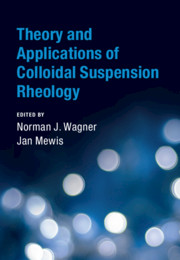Book contents
- Theory and Applications of Colloidal Suspension Rheology
- Cambridge Series in Chemical Engineering
- Theory and Applications of Colloidal Suspension Rheology
- Copyright page
- Dedication
- Contents
- Contributors
- Preface
- General List of Symbols
- Useful Physical Constants and Values
- 1 Introduction to Colloidal Suspension Rheology
- 2 Theory of Colloidal Suspension Structure, Dynamics, and Rheology
- 3 Methods of Colloidal Simulation
- 4 Microstructure under Flow
- 5 Rheology of Colloidal Glasses and Gels
- 6 Suspensions of Soft Colloidal Particles
- 7 Biocolloid Rheology
- 8 Hemorheology
- 9 Applications
- Index
- References
1 - Introduction to Colloidal Suspension Rheology
Published online by Cambridge University Press: 07 April 2021
- Theory and Applications of Colloidal Suspension Rheology
- Cambridge Series in Chemical Engineering
- Theory and Applications of Colloidal Suspension Rheology
- Copyright page
- Dedication
- Contents
- Contributors
- Preface
- General List of Symbols
- Useful Physical Constants and Values
- 1 Introduction to Colloidal Suspension Rheology
- 2 Theory of Colloidal Suspension Structure, Dynamics, and Rheology
- 3 Methods of Colloidal Simulation
- 4 Microstructure under Flow
- 5 Rheology of Colloidal Glasses and Gels
- 6 Suspensions of Soft Colloidal Particles
- 7 Biocolloid Rheology
- 8 Hemorheology
- 9 Applications
- Index
- References
Summary
The content of this chapter provides a brief overview of the basic concepts of colloid science that will be used in this book. Foundational knowledge is provided by reviewing our understanding of the simplest case of suspensions of hard spheres. First, the characteristic properties of Brownian hard spheres are presented. This includes a discussion of the relevant forces on and between particles in fluids at rest or during flow. On this basis, the microstructure and the phase behavior of the suspensions under consideration are evaluated. The basic rheology of hard sphere suspensions is reviewed in some detail, covering linear and nonlinear shear behavior, oscillatory flow, and also normal stress differences and shear thickening. The rheology is discussed in relation to the effect of flow on microstructure. As a foundation for understanding more complex suspensions, some basic colloidal interaction potentials are introduced along with their resulting, rich phase behavior. A special section of this chapter is dedicated to thixotropy, as this phenomenon occurs in several of the real life systems discussed in subsequent chapters. An appendix reviews the basic rheological concepts as an aid to the reader.
- Type
- Chapter
- Information
- Publisher: Cambridge University PressPrint publication year: 2021
References
- 1
- Cited by

